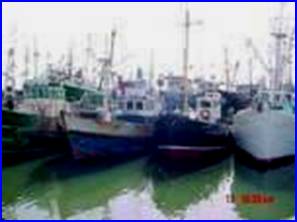INDUSTRIAL & COMMERCIAL FISHING CATEGORIES
The high seas and coastline areas of Mauritania are favourable to contact between species requiring a temperate environment and those needing a tropical one. This zone is characterized by the up welling phenomenon, an exchange between deep cold waters and surface warm waters, which promotes great biological richness aSnd diversity.
The overall Mauritanian potential for yearly catches is approx. of 1.5 million tons, principally small pelagic fish (900 000 tons) and shell fish (venus clam), which are currently very little exploited. Mauritanian waters comprise over 500 species, from which only 100 are commercialized. In terms of volumes, the exports increased by 6.2% between 1997 and 2000 when the domestic consumption remained low and was estimated at less than 16,000 tons per year
In 2001, the total captures in the Mauritanian EEZ amounted to more 642,000 tons, among which 620,000 tons for the industrial fishing fleets that mostly catch pelagic species. According to the Law, fishing categories are characterized by the type of gears employed to catch the fish.
Basically, there are two fishing gear categories:
1. The non specific gears which are not supposed to be harmful to the halieutic environment.
2. The specific gears which allow for sizeable catch by mean of modern specialized equipment, with more stress on the halieutic environment.
In order to closely monitor the access to its halieutic resources, Mauritania has developed a scope of different license categories:
Coastal fishing license (no dedicated fishing gear)
Pelagic fishing license
Demersal fishing license
Tuna fishing
Shrimp fishing
Lobster fishing
Cephalopod fishing
Black hake fishing
Shell fish catch (currently almost unexploited).
Applicable rules and regulations are not all the same for each of these licenses.



 - °
- °

